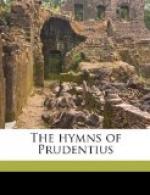“Transmissa raptim praeda cassos dentium eludit ictus incruentam transvolans inpune linguam, ne retentam mordicus offam molares dissecarent uvidi, os omne transit et palatum praeterit.
Ternis dierum ac noctium processibus mansit ferino devoratus gutture, errabat illic per latebras viscerum, ventris recessus circumibat tortiles anhelus extis intus aestuantibus.”
194 Prudentius appears to have believed that the
mystery of the
Incarnation was concealed
from Satan, and that the Temptation
was an endeavour to
ascertain whether Jesus was the Son of God
or no. Cf.
Milton, Par. Reg. i.:—
“Who
this is we must learn, for Man he seems
In
all his lineaments, though in his face
The
glimpses of his Father’s glory shine.”
VIII
9 The day of twelve hours appears to have been
adopted by the
Romans about B.C. 291.
Ambrose (de virginibus, iii. 4), commenting
on Ps. cxix. and the
words “Seven times a day do I praise thee,”
declares that prayers
are to be offered up with thanksgiving when
we rise from sleep,
when we go forth, when we prepare to take food,
when we have taken it,
at the hour of incense, and lastly, when we
retire to rest.
He probably alludes to private prayer. The stanza
here indicates that
the second hour after midday has arrived, when
the fasting ended and
the midday meal was taken.
14 The word festum, as in vii. 4, indicates
a special fast day.
Until the sixth century,
fasting was simply a penitential discipline
and was not used as
a particular mode of penance. In the fourth
century it was a fairly
common practice as a preparation for Holy
Communion. Fasting
before Baptism was a much earlier practice.
The stated fasts of
the Western Church were (1) annual, that
is, ante-paschal or
Lent; (2) monthly, or the fasts of the four
seasons in the 1st,
4th, 7th and 10th months; (3) weekly, on
Wednesday and Friday.
There was also the fast of the Rogations and
the Vigils or Eves of
holy days. It is doubtful whether all these
were in vogue as early
as Prudentius.
33 This passage on the Shepherd reminds us of
one of the most common
pictorial representations
of the Catacombs. Christian art owed
something to paganism
in this matter; ancient sculptures represent
the god Pan with a goat
thrown across his shoulders and a Pan’s
pipe in his hand; while
the poets Calpurnius and Tibullus both
refer to the custom
of carrying a stray or neglected lamb on the
shoulders of the shepherd.
Going further back, the figure is common
in the O. T. to express
God’s care over His people. Our Lord
therefore used for His




